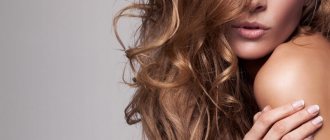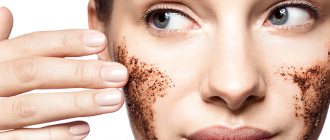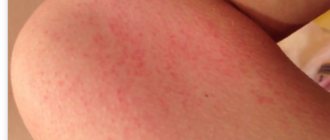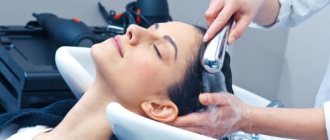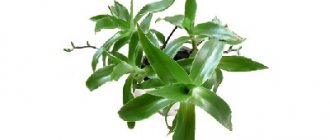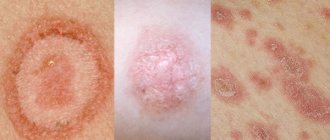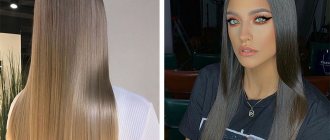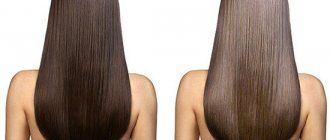The procedure is performed:
Angelina Mikhailovna Dubskaya
Chief physician, cosmetologist, certified Aptos doctor
Hair is an appendage of the skin. Of the three types of hair (long, bristly and vellus), the hair on the head is long.
Hair (pili - Latin, trichos - Greek) is divided into a shaft - the part of the hair that is visible above the surface and a root, which is located in the dermis (directly in the skin).
The deepest, widest part of the root is called the hair follicle, due to which hair growth occurs. The root and bulb are located in a special sac (made of epithelial cells), surrounded by a connective tissue sac, called the hair follicle. At the base of the follicle, a hair papilla protrudes into the hair follicle, containing vessels that feed the follicle. The hair follicle has a cylindrical shape and opens to the surface of the skin with a peculiar expansion called the hair follicle funnel (or the mouth of the hair follicle), in which the shaft passes freely. The excretory ducts of the sebaceous glands open into the follicle. Near each follicle there are one or more sebaceous glands, the secretion of which is a product of the breakdown of sebaceous gland cells (sebum).
The hair follicle consists of cells that constantly multiply and contain a large amount of pigment (normally). Hair follicles are intertwined with a large number of nerve fibers. The trophic (nutritional) function in relation to hair is carried out both by the nervous system and by hormones of some glands by internal secretion (pituitary gland, thyroid gland, gonads).
1. Oily seborrhea:
3. Hair loss:
5. Seborrheic eczema, eczematid.
Seborrhea is a skin lesion based on a violation of the secretory function of the sebaceous glands, expressed in increased secretion and qualitative changes in sebum. Based on the characteristics of the physicochemical composition of sebum, which determine its consistency, three forms of seborrhea are distinguished: liquid, thick, mixed.
Liquid seborrhea is characterized by increased secretion of sebum, the skin quickly becomes oily, the mouths of the hair follicles gape and dilate. The hair on the head is covered with a layer of sebum and is very shiny, stuck together, and by the age of 20 it begins to fall out. Disruption of the secretion of the sebaceous glands in this form of seborrhea is characterized by an increase in the amount of sebum secreted. To a lesser extent, its qualitative changes are expressed, which are manifested by a decrease in the amount of free lower fatty acids, which have fungicidal (antifungal) and bactericidal (antibacterial) properties.
With thick seborrhea, increased sebum secretion is less pronounced, hair does not fall out, and, as a rule, baldness does not occur. Here the leading role is played by the endocrine factor, in particular dysfunction of the gonads. Qualitative changes in sebum come first - a lower content of free fatty acids and an increase in the amount of bound fatty acids and unsaponifiable substances (cholesterol). The composition of sebum in thick seborrhea includes a large number of partially keratinized and oily-degenerated cellular elements, due to which it acquires a denser character. With thick seborrhea, hyperkeratosis (increased keratinization) is noted, especially at the mouths of the hair follicles.
Mixed seborrhea is more common than other forms and can lead to hair thinning. Seborrhea is based on changes in the normal physiological state of the sebaceous glands, which arise under the influence of dysfunctions of the endocrine and nervous systems that regulate their secretory function. With liquid seborrhea, pronounced changes in the autonomic nervous system are observed.
Dandruff is a scalp-like peeling of the scalp in the absence of inflammatory phenomena (difference from seborrheic eczema and eczematitis). Often accompanied by itching. Contamination of the collar and shoulders of outerwear is noted. With seborrhea, dandruff has greasy scales. Often, dandruff can refer to an infectious disease caused by the fungus pityrosporum oval, which is a saprophyte of the scalp, and with appropriate changes in the skin environment, it receives favorable conditions for its development and acquires pathogenic properties. Such conditions arise in particular when there are changes in the chemical composition of sebum in patients with seborrhea. Predisposing causes also include decreased nutrition, lack of B complex vitamins in the body, chronic diseases (especially the gastrointestinal tract), fatigue, and neuropsychiatric disorders. One may note increased flaking of the scalp due to exposure to aggressive chemicals (dyes, perms).
Hair loss (alopecia)
Early hair loss occurs more often with liquid and mixed forms of seborrhea, especially in combination with dandruff, and often leads to baldness in men, thinning and thinning of hair in women. The hair that falls out is first replaced by new ones, but the hair that grows back becomes thinner with each new change, finally turns into vellus hair and ultimately disappears completely. Early baldness begins in the frontoparietal regions and the crown. The causes of this baldness are neuro-endocrine disorders and often hereditary-constitutional factors (family suffering, androgenic alopecia). The prognosis is often unfavorable.
Symptomatic baldness is a consequence of severe illnesses (severe infections, vitamin deficiencies, pregnancy and other diseases) and usually begins acutely with total hair thinning. The prognosis is favorable.
Localized (focal) baldness begins suddenly, more often in young people 15-30 years old. One or several bald spots are formed, which slowly increase in size up to 5-1 cm in diameter, which can merge. The surface of the skin in the area of bald spots is smooth, shiny, hair at the edges is easily pulled out, sometimes broken off at a height of 0.5-1cm. from the mouth of the hair follicle. The hair root is thinned and has the shape of an exclamation mark. After a few months or years, bald spots can be overgrown first with vellus hair, and then with normal hair, which is initially depegmented. Transition to total baldness is possible. The reasons are not exactly clear. Trophic skin disorders caused by changes in the functional nervous system (sympathetic) and endocrine glands (pituitary-adrenal system) were identified.
Eczema – we have seborrheic eczema, it is observed in people suffering from seborrhea and is often localized in addition to the face (nasobuccal folds, eyebrows) in the scalp. It is characterized by a rash of small precise follicular nodules of a yellowish-pink color, covered with fatty, grayish-yellow scales. The nodules coalesce into plaques covered with fatty scales, which can form large lesions. Subjectively, there may be mild itching. The cause is often low-pathogenic purulent bacteria (pyococci) that constantly live on the surface of the skin. The predisposing cause of the development of the disease is disturbances in the secretory activity of the sebaceous glands, leading to a decrease in the bactericidal properties of sebum and a decrease in the acidity of the skin surface. The disease is easy to treat, but is prone to relapse.
Eczematid is a peculiar form of microbial eczema. It is characterized by a rash of one-time spots of varying sizes, irregularly shaped, completely covered with either pityriasis-like or fine-plate scales, with possible dotted crusts among them. Less commonly localized on the scalp.
Problems of the hair shaft itself - damage, breaks in length, split ends, frayed ends - often depend on both skin problems and external influences (aggressive chemical, thermal, mechanical influences). Please note that hair damage can be caused by a fungal infection.
Superficial trichophytosis of the scalp is characterized by pale pink round lesions with grayish pityriasis scales. Hair damaged by fungi breaks off at a distance of 2-3mm above the skin level and looks like black dots on the skin. This form is observed more often in children during puberty, with hormonal changes in the function of the sebaceous glands and changes in the chemical composition of sebum. Microscopic examination of the hair reveals elements of a fungus. It can also be observed in adult women as a chronic form in the form of black-spot trichophytosis, in which, against the background of slightly flaky patches of skin, hair breakage is observed at the level of the exit from the follicle. It is most often localized in the occipital and temporal regions, but can be scattered throughout the head.
Microsporia - occurs when infected from people or animals. It is expressed in the formation of one or two large or several small lesions, regular round in shape, pink in color with small flour-like scales. All hair above the lesion is broken off at a height of 4–6 mm above the skin level, as if cut short, but white in color, which is explained by the presence of a sheath of fungal spores on each hair, and can be easily pulled out with tweezers.
Favus (scab) - mainly affects the scalp in humans. The fungus (achorion) invades the hair follicle and affects both the root and shaft systems of the hair. Hair becomes dull, gray, and easily pulled out. Massive crust-like layers form on the skin, in place of which a permanent scar and baldness can occur.
Fungal hair infections are diagnosed by specialists, but should be taken into account by everyone who works with hair.
Hair damage that is a purely cosmetic defect (without damage to the skin) is easy to differentiate and generally requires proper care.
Elimination of hair and scalp problems is aimed at eliminating internal changes (restorative treatment, sedative vitamin therapy) and external manifestations (adequate care, anti-inflammatory therapy, improvement of trophism).
Proper care for oily scalp
The first thing you need to start with is nutrition. Review your eating habits and diet. Avoid everything fatty, fried and carcinogenic. It would be a good idea to reduce your consumption of sweets or even give up baking and chocolate. Instead, you need to eat fresh vegetables, fruits, dried fruits and honey every day. It will have a good effect on the condition of your hair and giving up bad habits. Alcohol and smoking only make things worse.
External care also has its own rules that must be followed. If you have oily scalp, you should avoid the following points:
- Using a hair dryer
- Washing your hair with hot water (it is better to wash your hair with cool water)
- Complex tight hairstyles and styling
- Styling products
- Long hair (hair should be of medium length or short during treatment)
- Using curling irons and straightening irons
- Metal accessories: hairpins, barrettes, bobby pins, etc.
- Head massage
- Contact of the brush with the skin while combing
- Frequent scratching
- Care that does not match your hair type
- Hair coloring
- Perm.
It is also worth washing your comb regularly, because particles of sebum remain on it. A dirty brush spreads old oils through your hair.
Washing head
The most common myths and misconceptions relate to washing your hair. Some people think that you need to wash oily hair as often as possible, others think that you should wash your hair less often, then your hair will become less oily. Both of these statements are misconceptions. You need to wash your hair as it gets dirty and regularly, not every day.
Frequent washing, on the contrary, stimulates the secretion of sebum. Hard water and aggressive components of shampoos negatively affect the scalp and force it to constantly replenish the damaged protective film, which causes the hair to become oily at the roots even more intensely than before.
It is best to wash your hair in the morning, as the sebaceous glands work most actively at night. Determining the regularity of washing in each individual case can only be done experimentally. However, try to avoid daily washing and completely give up the intention of washing your hair several times a day. The best option is to wash your hair once every 3 days.
Hair washing should consist of two stages:
- Cleansing
- Hydration
To cleanse, you need to use a mild shampoo without parabens, sulfates and silicones.
When washing your hair, a small amount of shampoo should first be applied to your hand. Then add some water, preferably cool. After this, lather the shampoo and apply it to your head. It is important to repeat this action twice. Then rinse the shampoo thoroughly. Shampoo residue on the hair negatively affects its condition and weighs down already heavy, oily hair.
Helpful Tips:
- While applying shampoo, it is good to massage your head. This will improve blood circulation and stimulate the hair follicles.
- If you have an oily scalp and dry hair, you should only apply shampoo to the scalp. When rinsing off the shampoo, the remaining product will end up on the ends. For dry hair, this rinsing is enough to remain clean, but not over-dried. After shampoo, apply a nourishing conditioner or balm to the ends of your hair.
- It is advisable not to wash your hair with running hard water. It is best to soften the water first or, in extreme cases, boil it. If this is not possible, you need to finish washing your hair with slightly oxidized water. This can be regular or apple cider vinegar in a proportion of 1 tablespoon per 1 liter of water, citric acid or lemon juice diluted in water. Herbal infusions are good for rinsing. Chamomile has antibacterial and anti-inflammatory properties. Oak bark will help normalize hair secretion. True, this infusion can color hair, so it is well suited for owners of dark hair and red-haired girls. An infusion of calendula and nettle is also good for rinsing.
Scalp and hair disease
A person can avoid the harmful effects of weather by following the recommendations of doctors:
- Do not walk without a hat at low temperatures. Starting from plus 5 degrees, you should cover your hair with a hat.
- Do not expose your hair to direct sunlight. In hot weather above plus 25 degrees, you need to hide your head under a Panama hat or a light scarf.
- Nowadays, rains with high acidity are already becoming the norm. Do not expose your hair to the rain. It is necessary to protect them by putting on a hood or hat if you do not have an umbrella at hand.
- Scalp problems can occur after a long stay on a polluted city street. Arriving home, you need to take a shower, wash off the soot and dust from your body and hair. There are special shampoos for everyday use.
- It is important to understand that wrapping your hair and overheating is also harmful. A sweaty head becomes covered with greasy fat faster.
Hair loss often occurs due to improper care and rough combing:
- Hair coloring is stressful for the hair shaft and hair follicle. Chemical ingredients can cause irreparable harm and disrupt the structure of the entire hairline. It is necessary to approach the choice of paint very carefully. Preference should be given to natural dyes with natural protein, such as Sim Sensitiv paint.
- Do not get perms more than once every six months.
- Problems with the scalp occur when hair is dried incorrectly with a hairdryer, straightened with an iron, or after curling with a curling iron.
One of the common causes of excessive hair loss is vitamin deficiency. You can choose a general complex, or it is better to take special vitamins for the scalp and hair. In such complexes the content and concentration of vitamins and minerals are carefully selected, hair loss stops after 2-3 weeks.
It is necessary to choose products for the scalp without synthetic surfactants, with the addition of medicinal components. Natural shampoos and conditioners include nourishing and strengthening ingredients in the formula.
Seborrhea in its advanced form leads to hair loss. Even at the beginning of the disease, dandruff or greasy yellow scales on the head significantly spoil the appearance. Meanwhile, treating the scalp at home will help get rid of seborrhea in a few weeks.
How to identify oily hair?
They look stale and unkempt. This is due to the sebum coating. Therefore, the curls quickly become dirty and look untidy. Facial skin has the same reason for oiliness.
According to cosmetologists, the film is useful because it helps protect curls from the negative influences of the environment. But still, hair and oily facial skin look unattractive. Even daily washing does not help. This is usually associated with the development of seborrhea, which causes dandruff. Facial skin looks oily.
Facial skin, as well as oily hair, must undergo comprehensive treatment, after which the first results will be noticeable. Therefore, it is important not only to choose the right shampoo and other cosmetics, but also to constantly perform therapeutic masks. Thanks to them, hair and facial skin are moisturized.
How to treat seborrhea?
The disease is treated by a specialist - a trichologist. It is believed that at the first signs of seborrhea you should consult a doctor, since the disease in its advanced form leads to complete or partial hair loss.
For successful treatment, it is necessary to establish the cause of the disease: changes in hormonal levels, proliferation of fungal flora of the epidermis, etc.
The doctor prescribes various tests to identify the causative agent of the disease. The cause of seborrhea determines the treatment.
Home treatment for seborrhea
Home treatments for seborrhea show excellent results.
But if 3-4 weeks after the start of therapy the skin condition has not improved, it is recommended to consult a specialist to avoid baldness. Recipes from traditional healers can be effectively combined with conservative treatment under the supervision of a physician. In this case, it is better to discuss with the doctor the compatibility of home treatment with drug therapy.
If seborrhea of the scalp occurs, treatment at home is carried out in accordance with the following recommendations.
- Diet. During treatment, you should avoid salty, spicy, fatty foods and sugar in any form. Regular cereals (not instant), fruits and raw vegetables, fermented milk products will help the body cope with the disease.
- Taking mineral and vitamin complexes. Seborrhea often appears when the body's immune strength decreases. Taking balanced complexes of minerals and vitamins will restore your own defense mechanisms. Vitamins B, A and E and zinc are especially important. You should pay attention to special complexes designed to improve hair condition.
- Healthy daily routine. To improve immunity, 8 hours of sleep at night and daily half-hour walks in the fresh air are recommended.
Cosmetic care products
Absorbent mud paste
Absorbent mud paste is a prefabricated complex for regulating the functioning of the sebaceous glands and restoring the normal water-lipid balance of the scalp. The specially developed mud paste formula guarantees therapeutic and preventive effects.
. As a result of systematic use, the microflora of the scalp and the functioning of the sebaceous glands are normalized, and the oily sheen on the hair disappears.
Balm "Isis"
Rinse aid from Natural Siberica
Natural product based on herbal decoctions and extracts. The balm has a mild cleansing and softening effect and does not harm the skin.
. Burdock and peppermint extracts help normalize the functioning of the sebaceous gland, and linden juice relaxes the tense muscles of the hair follicle, which provides a pleasant tonic effect on the skin.
Air conditioner from Timotei
An excellent choice for people who are allergic to certain herbs or oils. This product consists almost entirely of synthetic elements, which does not make it worse than natural conditioners, because the formulas are selected in such a way as to provide gentle care without causing allergies or irritation. Works great against oily skin, washing away excess sebum without harming the sebaceous glands.
Bio-balm from Giardini
Gentle care and long-lasting hydration are guaranteed. Biologically active components are as close in composition as possible to those found in our body
, therefore they easily overcome the immune barrier and enter the body unchanged. Due to the high level of bioavailability (ratio of ingested substance to absorbed substance), this balm has no competitors in terms of price/quality ratio.
Tonic balance from Belit
A good selection of inexpensive drugs with a mild effect. Natural oils and extracts included in the composition work together. They relieve inflammation from the sebaceous gland and provide it with nutrients for normal functioning. At the same time, it eliminates excess sebum and cleanses the skin of impurities and fatty acid oxidation products.
Essential oils
A special range of natural preparations for regulating skin oiliness. Provides skin with fatty acids that balance fluid balance and lipid profile. Use with caution by people allergic to the solvent or components of the composition.
. To check, it is better to put a couple of drops on your wrist and wait 10 minutes to make sure that you are not allergic to this oil.
Read more about the effect of oils on the scalp.
Oily seborrhea: home treatment
It is recommended to wash your hair with mustard powder once a week - without detergents. Frequent use of mustard powder dries out the scalp.
A teaspoon of ammonia is diluted in a glass of warm water. Rinse washed hair with this solution.
A tablespoon of crushed oak bark is boiled for 10-15 minutes in a glass of water (water bath). The broth is filtered and a spoonful of honey is dissolved in it. The mixture is rubbed into the damaged epidermis, the head is wrapped in a scarf and the product is left for 1 hour.
The product helps destroy the fungal flora of the epidermis. 100 g of unripe walnut peel is crushed and poured with half a liter of vodka (alcohol). Keep the tincture for 15 days. The product is rubbed into the scalp.
- St. John's wort, yarrow, and oak bark are mixed in equal proportions. Boil a spoonful of the mixture in a glass of boiling water for 1 hour (water bath). The cooled decoction is used to rinse the head.
- A decoction is prepared from chamomile flowers: 2 tablespoons of the raw material are boiled for half an hour in a glass of water (water bath). The strained broth is used for rinsing, lotions and compresses.
- A spoonful of St. John's wort is infused in a glass of boiling water. The tincture is used to wipe the scalp or make lotions.
Causes of increased oily hair
Why is my hair oily? The answer to this question is individual in each specific case, but the root cause of unaesthetic hair is always the excessive formation of sebum.
With normal, physiological function of the sebaceous glands, their secretion forms a hydrolipid film on the scalp. A thin fatty mantle performs a protective function and prevents drying of the scalp, prevents moisture loss and the penetration of ultraviolet rays, bacteria and dirt into the scalp.
The activity and number of sebaceous glands are programmed at the genetic level. Accordingly, it is impossible to radically influence their function. You can improve the condition of your scalp through proper daily care and nutrition.
So, the main reasons for increased greasiness in hair:
- Hormonal changes - adolescence, pregnancy and menopause in women, stress. During the period of hormonal changes, the production of the hormone testosterone increases, which means the sensitivity of the sebaceous glands to it also increases.
- Internal reasons. Dysfunction of the endocrine system, gastrointestinal tract, and nervous system also negatively affects the condition of the hair. This reason is most often identified when the hair suddenly becomes oily.
- Seborrheic dermatitis . One of the pathological causes of oily scalp (see), in which not only the amount of sebum increases, but also its composition changes (see).
- Diet . Spicy, fatty, smoked, salty and canned foods, sweet soda, fast food, alcohol, and confectionery can increase sebum production.
- Incorrect care. Excessive use of greasy masks and oils. Constantly wearing hats made of synthetic materials, etc.
- External factors, such as high humidity and heat, enhance the function of the sebaceous glands.

